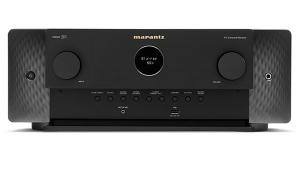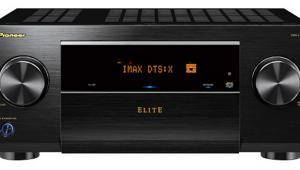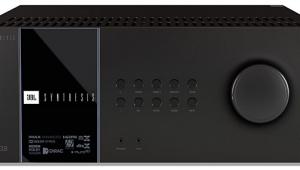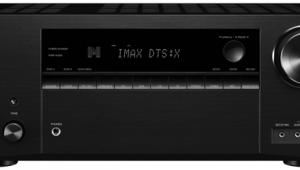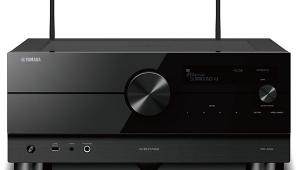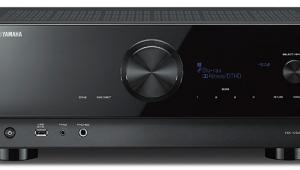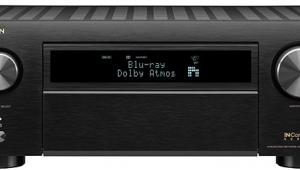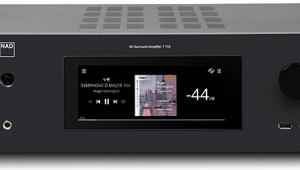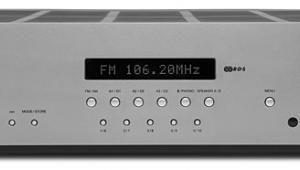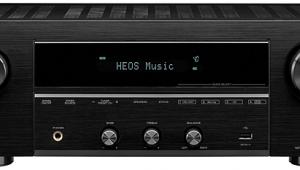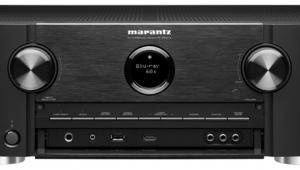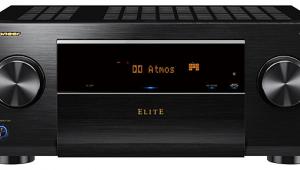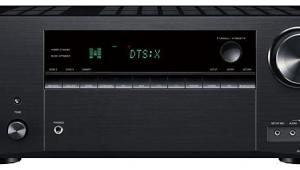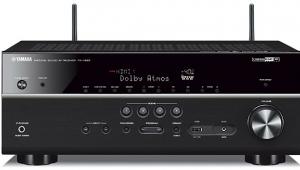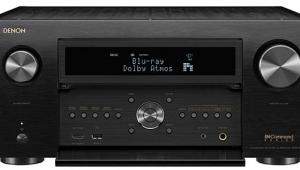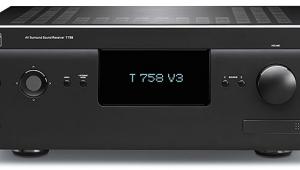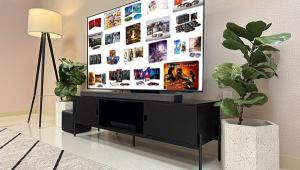Denon AVR-5803 A/V receiver & DVD-9000 DVD-Video/DVD-Audio player Page 4
I quickly forgot about the instruction manual when I saw the picture the DVD-9000 produced from filmed material. Viewed on the 65-inch Hitachi 65XWX20B rear-projection display (currently being reviewed), the Denon produced superb, 3-dimensional-looking pictures that were notably low in video noise, with colors that were richly saturated and well-balanced. Issues of chroma upsampling that I'd noted with the earlier Denon DVD-2800 were nonexistent. The DVD-9000's Silicon Image scaler performed superbly. When I auditioned Star Trek: Insurrection, the opening "hay scene" was essentially free of glitches on both the haystack and the tops of the buildings. When the Hitachi was being calibrated—using the Denon player—the test patterns for bandwidth, chroma delay, and resolution all looked fine. Overall, the picture quality was hard to fault.
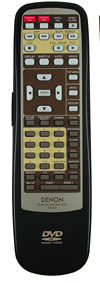 I watched a whole lotta movies, and the gestalt was more than satisfying and enjoyable in that I didn't notice any "sins of commission." I started with scenes from The Haunting, which had given the DVD-2800 so much trouble because of MPEG decoding problems that involved disconnected movement of red items and a noise-like shimmering. With the 9000, these issues were solved; low-light scenes, including ones with a great deal of red, were presented with the same level of clarity and transparency as very bright scenes. I moved on to darkened desert scenes in Lawrence of Arabia, where I'd noticed the same odd movement. Problem solved in the 9000.
I watched a whole lotta movies, and the gestalt was more than satisfying and enjoyable in that I didn't notice any "sins of commission." I started with scenes from The Haunting, which had given the DVD-2800 so much trouble because of MPEG decoding problems that involved disconnected movement of red items and a noise-like shimmering. With the 9000, these issues were solved; low-light scenes, including ones with a great deal of red, were presented with the same level of clarity and transparency as very bright scenes. I moved on to darkened desert scenes in Lawrence of Arabia, where I'd noticed the same odd movement. Problem solved in the 9000.
I'd been sitting on a Netflix copy of the quirky French flick Amélie, an intimate and charming film photographed somewhat darkly and, by coincidence, often bathed in a reddish glow. Again, I saw no visible problems, and the visibly grainy texture of the film stock gave it an "authentic" cinematic look and feel.
Then, I watched Toy Story on both the 9000 and my reference Camelot Round Table DVD player. I thought the Denon had perhaps greater color vibrancy and a tad greater clarity and sharpness, but the differences were not ones I'd bet the farm on noticing in a blind test. In part, this may be due to the fact that both players use Silicon Graphic's PureProgressive deinterlacing technology, though Denon's is the latest version. Could I say that Denon's 14-bit digital D/A converters contributed to a noticeable improvement over the Camelot? No.
Before packing the player up and sending it off for photography, I watched Hitchcock's Vertigo, and, on the 65-inch Hitachi RPTV at least, the experience was as flawless as I've seen a DVD player deliver that film. I can't say I noticed any new details or that the player shed new light on the cinematography, just that it got out of the way and let the film create its magic.
If you haven't seen these films, the examples above might mean nothing to you. And even if you have, you were probably watching the movie and not picking it apart, not looking for "gotchas" or little discontinuities or mistakes. The most important thing is that I found the experience to be transparent and convincingly "filmlike." In many ways, I was reminded of the Ayre D-1x, which sets itself apart from any other player I've seen with the totality of its performance—even though it suffered from a minor form of the dreaded MPEG-decoder chroma bug.
I don't think you can go wrong with the DVD-9000's subjectively outstanding video performance. If you want the picture sharper than the factory defaults can provide, you can add more edge definition in one of the memory settings, but at the expense of the default setting's detailed yet filmlike texture. [For our measured luminance response on the DVD-9000, see the table on pg. 63.—Ed.]
But these days, there are many great, relatively inexpensive players out there. Scanning glitches and other obvious bugs that plagued many earlier players are pretty much non-issues. Do you need to spend more than $3000 to get DVD-Video performance comparable to the Denon's? I don't think so. Not being an equipment hoarder, I didn't have a stable of players in my storage room to compare. But when it comes to DVD players, the law of diminishing returns begins to apply well downmarket. If sophisticated 2-channel CD sound and multichannel DVD-Audio playback don't interest you, you probably can get comparably good video performance for much less, but without the Denon's superb build quality. Don't sell short such attractions as touch, feel, and overall pride of ownership. You get those with the DVD-9000.
Sound
While the DVD-9000 didn't quite measure up to the superb 2-channel sound of Camelot Technology's Round Table Mk.2 DVD player, it came close enough that this wasn't an issue—except in direct comparisons. The Round Table's 24/192 upsampling circuitry yielded a slightly richer, warmer midrange and somewhat tighter, more rhythmically lithe bass. However, overall detail and dimensionality were comparable.
On the other hand, the more expensive Camelot is based on the now-geriatric Panasonic A-110 DVD player. It can't play CD-Rs or decode HDCDs, which the Denon can, and its build quality isn't nearly as good as the Denon's. Plus, the Camelot is not a multichannel DVD-A player. Of course, if you buy Denon's matching AVR-5803 receiver, you end up with redundant high-quality, hi-rez, 2-channel CD D/A conversion anyway.
For a detailed comparison of the DVD-Audio and SACD formats, see my "Digital Audio: The Next Generation" feature in the January 2003 Guide. If you're interested in DVD-A, the Denon's sophisticated multichannel performance fits the bill. Particularly impressive was the DVD-9000's smooth, extended, and detailed top end. The super-high-quality recordings from the AIX label profiled in "Digital Audio: The Next Generation" demonstrated just how sweet, airy, and extended 5.1-channel, 24/96 PCM could sound from the DVD-9000.
When I compared that level of resolution to the 2-channel, 24/176 DVD-A mix of Jonathan Brooke's Steady Pull (Bad Dog BDR-DV-61001, the sound got even better, with more air, extension, detail, and subtle harmonic definition. It was so much better that I preferred the 2-channel version to the 5.1-channel 24/96 mix. There was more depth at the higher resolution in two channels than at the lower resolution in 5.1.
I didn't try using the DVD-9000 as an external DAC, nor could I figure out why I'd want to—especially when I had the AVR-5803.
Conclusions
The Denon DVD-9000 is an expensive and ambitious DVD-Video/Audio player. If you're interested in a superb-sounding multichannel DVD-A player and a high-performance, progressive-scan DVD-V player—and even if you don't need Denon's matching AVR-5803 receiver—the DVD-9000 is an all-in-one solution well worth considering. When mated with the 5803 via the Denon Link and multichannel analog connectors, there's an additional synergy, though don't be surprised if, because of shortsighted copy-protection schemes, many DVD-A discs won't work through the Denon Link.
If multichannel DVD-A is not on your radar screen, you can get comparable if not identical DVD-V performance from a less expensive player, though not with the same superb build quality or, for now, 14-bit video DACs. But considering its overall audio and video performance, its ultra-high build quality, and its versatility, the DVD-9000 is a bargain for the right buyer. I hope it finds a cozy niche for itself, and encourages other companies to build similar products.
